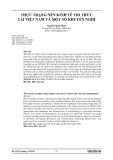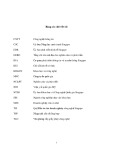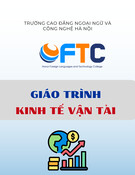
* Corresponding author
E-mail address: hoilq@neu.edu.vn (Q.H. Le)
© 2019 by the authors; licensee Growing Science.
doi: 10.5267/j.uscm.2019.4.003
Uncertain Supply Chain Management 7 (2019) 665–678
Contents lists available at GrowingScience
Uncertain Supply Chain Management
homepage: www.GrowingScience.com/uscm
The influence of individual characteristics in transfer of technical training in Vietnamese
enterprises
Thi Lan Anh Phama and Quoc Hoi Lea*
aCentral Economic Commission of the Communist Party, Vietnam
bNational Economics University, Vietnam
C H R O N I C L E A B S T R A C T
Article history:
Received March 9, 2019
Received in revised format April
1, 2019
Accepted April 18 2019
Available online
April 19 2019
This study investigates the relationships between individual characteristics (including outcome
expectation; perceived relevance of training; trainee ability) and transfer of technical training
(TTT) in Vietnamese enterprises. Quantitative method was employed to examine how
individual characteristics influence TTT. A self-completion questionnaire was administered to
185 employees in seven Vietnamese enterprises. All these employees received training from
their enterprise. The results show that three predicted individual factors significantly
influenced on TTT. Based on the findings, this study suggest that in order to motivate trainee’s
efforts to transfer, organisational changes should be conducted to offer bonus as well as
perceived relevance of training succeeding training activities.
., Canada
by
the authors; licensee Growin
g
Science2019 ©
Keywords:
Individual characteristics
Outcome expectation
Perceived relevance of
training
Trainee ability
Transfer of technical training
1. Introduction
The modern business environment is a highly competitive and global workplace for many organizations
(Werner & DeSimone, 2018). Business managers are conducting new and advanced strategies to face
with the turbulent environment and ensure success for their enterprises. A general subject of the most
popular plans is a focus on human capital or knowledge and skills of employees as a key strategic
resource for achieving and maintaining a competitive advantage. As business environment moves in
the area of the global marketplace, the demand to maintain a highly effective and skilled workforce
becomes an important element for developing market share (Noe, 2013). Training is the key to learn
and develop human capital. Employee training is crucial for business organizations to improve both
knowledge and skills for their employees. Therefore, organizations need to recognize that their training
investments produce dividends in terms of improved organizational performance such as increased
productivity and profit, improved safety statistics and reduced errors (Salas & Cannon-Bowers, 2001).

666
Much of the debate about the training - organizational performance linkage has been focused around
the concept of transfer of technical training (TTT) (Dirani, 2012; Massenberg et al, 2017). According
to Baldwin & Ford (1988), transfer of training is defined as the application of knowledge and skills
trained from training context to the job and its maintenance during a certain period of time. There have
been a number of causes, but mainly because of the regularly cited failure of training programs in both
education and business has not focused on how training is applied to the workplace (Cheng & Ho,
2001). Therefore, it is necessary for research to find responses about transfer of training. It is argued
that transitional economies rely heavily on human labor to maximize their effectiveness and meet their
organizational goals (King-Kauanui et al., 2006), so HR training becomes utilitarian in the organization
strategy to keep up with economic and technological changes. HR training and development programs
have to be linked to the strategic business development goals of the enterprise. Labor needs to be
reviewed as a source to be trained and developed for the purpose of enhancing the productivity of
enterprises (Zidan, 2001). It seems that human resource development (HRD) did not receive intensive
concern from Vietnamese enterprise’s managers in the past because they based their government
allocations of labor to fulfill their staffing needs. Vietnamese Enterprises view training as an expense
which would influence their profit levels, so financial investment in training and development was
limited and only 62% of the respondents have a little budget for training (Nguyen, 2011). The result of
this is a mismatch of skill with enterprise demand. In fact, about 25-40% of Vietnam’s 168,000 public
servants, meet some “standard requirements” (Ngo, 2008). According to the CLS Project Manager, the
majority of Vietnamese laborers have not been trained. The levels of soft skills, foreign language
proficiency, teamwork skills, information technology skills and creativity are still limited. In addition,
many Vietnamese workers, although trained, but still not meet the requirements of business owners and
take time to train again (Shone et al., 2018). As a result, The World Bank's survey indicated that,
Vietnam's human resources quality reached only 3.79 points on a scale of 10, ranking 11th out of 12
countries surveyed in Asia. the quality of human resources in Vietnam is now only 3.39 out of 10 while
some countries in the region such as Korea is 6.91, India is 5.76, Malaysia is 5.59 and Thailand is 4.94
(HL, 2017). Data of The General Statistics Office of Viet Nam reported that over 47% of Vietnamese
employees have no skills (Shone et al., 2018). Most of them come from agricultural or rural areas with
working habits of the small farm model such as arbitrary time, lack of skills, promoting individual
initiative and sharing experience (Report of Ministry of Education and Training, 2007). Therefore,
training and transfer of training have become utilitarian in the enterprise strategy to keep up with
technological and economic changes. The most effective avenue for enhancing performance and
staying competitive in Enterprises is developing the skills of employees (Nguyen & Bryant, 2004). The
skill development process, through vocational training, is by description, a gradual progression which
concerns a wide range of national institutions (both state and privately owned) and obtains payments
over the long term. Nevertheless, the skilled labor needs of industry and enterprises are primarily
immediate. They may not be able to ‘wait’ for the final result of skill development policies occurring
in the future. Therefore, it is more important that skill training mechanisms are set in place and the
impetus to skills upgrading and the effective transfer of trained skills to the workplace may come from
enterprises’ training policies. These activities should continue to be aided through targeted support as
individual characteristics including both trainee’s ability and dedicated motivation. Therefore the aim
of this study is on the evaluation of individual characteristic factors of training transfer effectiveness
on human resource practices in Vietnamese enterprises. An in depth analysis of the possible individual
factors influencing the achievement of training transfer will provide assistance for this study.
2. Literature Review
A considerable amount of literature has been published on TOT. These studies provide several theories
and conceptual frameworks that have been used to predict the factors that influence TOT. For example,
Baldwin and Ford (1988) carried out a widespread review of the literature, identifying key trainee
characteristic influences on the processes of pre-training, during-training and post-training. Since this
time, significant interest has been generated in this area. Three years later, Ree and Earles (1991)

T.L.A. Pham and Q.H. Le /Uncertain Supply Chain Management 7 (2019)
667
expanded the theoretical model of TOT to include an emphasis on transfer motivation, which is
predicted to be a key component to connect learning with individual performance change. Furthermore,
a study by Holton et al. (2000) addressed three theories of human behaviour that may impact on transfer
motivation, expectancy theory, equity theory and goal-setting theory. Expectancy theory is defined as
“a momentary belief concerning the likelihood that a particular act will precede a particular outcome”
(Yamnill & McLean, 2001: 197). According to this theory, certain behaviours will lead to desired
performance goals or incentive awards. An individual’s effort will result in the achievement of desirable
results. Numerous particular studies have, however, supplied additional documents on the connections
between learner ability and motivation factors with TOT. Devos et al. (2007) noted that trainees with
high confidence levels were more motivated to use their training. Employees who had effective career
planning and high job involvement would prefer to learn and transfer. Employee performance is a
function of motivation, ability of employee and opportunity to perform (Boxall & Purcell, 2011). In
addition, motivation to transfer and trainee ability have been found to be positively associated with
TOT. These factors may be job function, job position, performance outcomes expectations, learner’s
locus of control, self-efficacy, organizational commitment, training attributes, confidence and openness
to change. It is clear that the trainee not only lies at the centre of the TOT process, but also his/her role
in affecting the TOT has received a large amount of research attention. Particularly, there is an
increasing concern relating to motivational factors and their influence on transferring training and skills
to the job. The assessment of the role of individual-related factors should be a vital component in
developing TOT (Dirani, 2012).
Motivation to TOT was defined as “the employee’s effort to apply knowledge and skills leaned in
training context to a real work situation” (Chiaburu et al., 2010). Previous studies have indicated that
motivational factors associated with personal desire and the abilities of an employee to learn and
transfer are elements that bring about the trainee‘s effort to effectively transfer. Accordingly, in the
TOT literature, there are several aspects that relate to the motivation to transfer, such as the perceived
relevance of training and performance outcome expectancies. These aspects were examined because it
is likely that individuals with inadequate motivation are poor in mastering trained skills and subsequent
transfer performance. For example, a study by Chiaburu et al. (2010) was conducted to test three
motivational factors associated with transfer by conducting a questionnaire survey with 111 participants
in an organization in the Mid-Atlantic region of the United States. Their findings indicated that
individuals with higher motivation to transfer were more likely to training cognitions that may
effectively transfer the training into performance improvement than employees with lower motivational
factors.
2.1 Performance outcomes expectancies
Holton’s definition indicated that outcome expectancies are “the expectation that the changes in job
performance will lead to valued outcomes” (Holton et al., 2000: 345). The perception of an obvious
match between training-based increased performance and rewards suggests high outcome expectancies
and this situation will imply a strong motivation to TOT. This means that, if trainees notice a
“connection” between improved performance (resulting from applying their trained skills and
knowledge) and rewards (e.g. wage increases, promotions, bonuses, status rewards), this may influence
transfer effectiveness (Velada et al., 2007). Rewards may contribute to effective performance when
links between rewards and good performance are made (Wen & Lin, 2014). Trainees have a strong
belief that the provision of organizational outcomes may be controlled to facilitate the application of
trained skills to the workplace. When employees believe they may benefit from training, these
employees will be willing to effectively learn and transfer trained skills to their job. Thus, organizations
should clearly link performance with rewards and highlight the value of training. Additionally,
Gegenfurtner et al. (2009) proposed numerous main elements for motivating employees to attend
training courses and engage in TOT in the workplace, such as doing the job in a better way, improving
professional competence and being useful in solving problems on the job. These scholars identified that

668
the elements, which are associated with motivational factors, may be employed to explain the perceived
relevance of training when making decisions about TOT. The outcomes obtained from training,
including a wage increase, a bonus, or a promotion for accomplishing tasks in a more efficient way
using the learned skills are mostly related to individual motivation to attend a training program at the
workplace (Le & Chu, 2016).
2.2 Perceived relevance of training
It is argued that the perceived importance of training impacts not only the motivation to learn but also
the motivation to apply the newly acquired skills (Massenberg et al., 2015). According to McLean and
McLean (2001), training realization is defined as the fulfilment of the trainee’s desires through the
training gained. In a study relating to a positive training environment, Devos et al. (2007) noted that if
a trainee believes new skills may not be used in the performance of his/her job, there is no incentive
for them to effectively learn those skills. An employee who perceives his/her training is useful for the
actual job performance will devote more time and effort for training and the application of the new
skills than an employee who considers the training to be invalid for improving new skills (Cheng &
Ho, 2001). Particularly, individuals who perceived training as gaining a way to acquire job skills were
more motivated to learn and obtained a higher level of immediate skill transfer. A study by Wen and
Lin (2014) examined the effectiveness of training associated with employees’ attitudes toward the
motivation to learn and transfer. The study surveyed 316 employees from broad industries in Taiwan.
The findings indicated there was a relationship between the trainee’s approach to career planning and
job involvement. For example, if the trainee assumed there was a value in the training for their career
development, then the probability of behavioural adjustments would be higher than for others who did
not engage in the same level of career planning. According to Awais et al. (2013), when an individual
believes that the knowledge and skills learned in the training context will result in a high likelihood of
a salary increase, a promotion, or elevated feelings of satisfaction and self-worth and the motivation
related to training and transfer will also increase. As there is a relationship between the individual’s
level and a related positive benefit, there may be an increased demand for training to improve
performance.
2.3 Trainee ability
If motivation is essential for the development of skill levels, it may be debated that an individual’s
ability to make an effort is an important antecedent for obtaining higher levels of cognition and
understanding (Tracey et al., 2001). Ability is viewed as being a supporting aspect for training. Support
for the impact of individual ability on the training area has long existed in the literature (Grossman &
Salas, 2011). If effective training is to occur, the trainee must have the cognitive ability to learn.
Cognitive ability is considered to be one of the best elements of an employee‘s potential related to
training, transfer and performance (Holton et al., 2007). Trainees with a higher cognitive ability to
retain the learned knowledge, combined with higher levels of confidence, will easily understand
complex content and successfully perform the skills acquired through training (Grossman & Salas,
2011). The aspect of cognitive ability is illustrated by a study by Bates and Holton (2004) that examined
job-related workplace literacy skills of 1,079 employees in a state-level transportation department in
the southern United States. The purpose of this study was to test whether employee job-related
workplace literacy skill level influences the employee’s ability to transfer. The findings indicated that
employees with low literacy levels had higher expectations of the training received, but they were less
able to effectively transfer the new knowledge and skills because of their low literacy ability. Bates and
Holton (2004) concluded that cognitive ability of an employee in relation to their job has a direct
influence on the training process and their ability to transfer trained skills to the job. Furthermore,
psychomotor and cognitive ability may reveal a capacity to understand the content of the training
courses. Thus, if employees have a narrow cognitive capability to learn, their understanding of the
contents taught in the training context is also limited. When ability of an employee matches the

T.L.A. Pham and Q.H. Le /Uncertain Supply Chain Management 7 (2019)
669
requirements of training with job tasks, effective training and transfer may occur (Burke & Hutchins,
2007). Velada et al. (2007) suggested that three dimensions related to training effectiveness should be
investigated to describe trainees’ cognitive ability, these being understanding the contents learned,
identifying appropriate work situations and identifying ways to improve with practice. In addition, two
main elements of training effectiveness were also mentioned in relation to cognitive ability, being able
to remember the learned key topics and being able to use the new skills (Gegenfurtner et al., 2009).
Similar to cognitive ability, training retention has an impact on trainee performance due to its effect on
intentional resource capacity (Chiaburu et al., 2010). The results of training retention are directly related
to the generalization and preservation of training content on the job. Employees with a higher cognitive
ability can be better equipped with knowledge and retain information learned during the training
process. In a meta-analytic review of the transfer literature, the findings of Blume et al. (2010) showed
that there is a very strong relationship between training retention that employees retain the content after
training and the transfer of closed-skills training. Another important aspect of transfer is the
maintenance and application of training to a real work situation (Blume et al., 2010). Employees who
learn and retain the skills and knowledge offered the training programs have a greater opportunity to
be able to effectively transfer training to the job (Grossman & Salas, 2011). In addition to skill
improvement, these trainees also have more information and knowledge to understand where and how
their trained skills can be used to improve performance (Wen & Lin, 2014). The knowledge gained
from training has a positive effect on transfer of training. Therefore, the ability of the trainees to retain
the knowledge they have acquired in their training and to identify appropriate situations to apply their
new skills on their job is an essential element of transfer of training. The trainee’s ability is also
represented through performance self-efficacy. Self-efficacy is defined as “an individual’s general
belief that he is able to change his performance when he wants to” (Holton et al., 2000: 346). Self-
efficacy not only may have directive impact on choice of activities, but also through expectations of
final success, it may influence coping efforts once they are initiated. Expectations of efficacy determine
how much effort individuals need to expend and how long they need to persist in the face of difficulties
and aversive experiences.
The influence of self-efficacy on TOT has been broadly studied recently (Gegenfurtner et al., 2009;
Velada et al., 2007). These studies applied social learning concepts to examine the effect of an
individual’s belief in their ability to use trained skills on the job. Trainees with a high level of self-
efficacy will apply substantial effort to pass targets at difficult levels and master new behavioral
commands and levels of higher performance. In contrast, trainees with low self-efficacy will reduce
their effort to meet challenging situations (Grossman & Salas, 2011). For example, based on a meta-
analytic review of the relevant literature, Colquitt et al. (2000) found performance self-efficacy to be
an important predictor of both training outcomes and learning motivation. Some other researchers
followed their review and also confirmed a positive relationship between performance self-efficacy and
TOT, either directly or indirectly, through trainee motivation. A study by Chiaburu and Marinova
(2005) found that performance self-efficacy is positively related to pre-training motivation, which, in
turn, significantly predicts TOT. Research by Velada et al. (2007) proposed that performance self-
efficacy partly contributes to TOT through its effect on motivation. Chiaburu et al. (2008) found similar
assumptions after studying the importance of performance self-efficacy in transfer effectiveness.
Hence, it seems that the level of self-efficacy has significant implications on the facilitation of transfer
of training. Moreover, research has indicated that the combination of self-efficacy and expectancy
theory may impact on the motivation to learn and TOT (Gegenfurtner et al., 2009). This means that it
is important for employees to believe that they may learn and master the training material and expect
that there will be several benefits from the learning which can be applied to their job. In summary, the
extant literature on TOT suggests that trainees must have confidence in their ability to apply
competencies and persevere with challenging tasks. When individuals feel confident in their ability to
apply their newly acquired skills, the outcomes of transfer of training are more effective than with those
with low perceived self-efficacy.


























